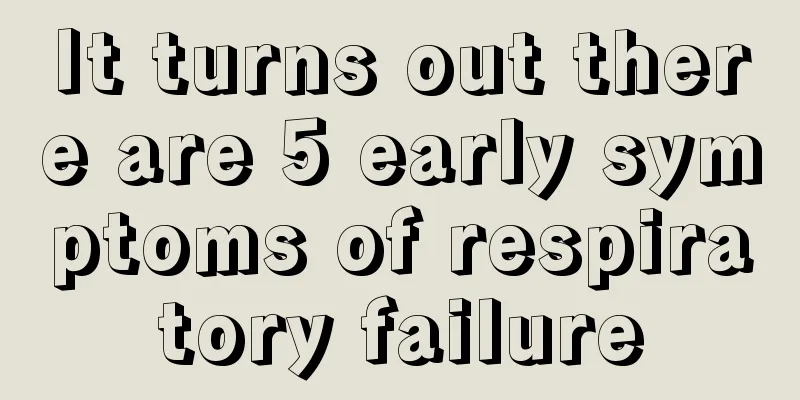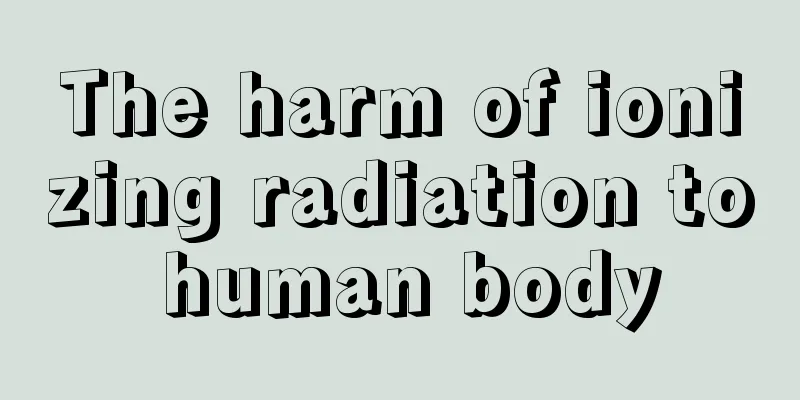It turns out there are 5 early symptoms of respiratory failure

|
Respiratory failure is a common disease in daily life. It can cause great harm to the physical and mental health of the human body. Therefore, it is particularly important to understand the early symptoms of respiratory failure and seek medical treatment in time. In fact, there are 5 early symptoms of respiratory failure in life. In addition to the clinical symptoms of the primary disease, multiple organ dysfunction is mainly caused by hypoxia and carbon dioxide retention. 1. Clinical manifestations of the primary disease Inspiratory stridor is a sign of upper airway obstruction, which is common in laryngotracheobronchitis, laryngomalacia, epiglottitis, foreign body aspiration and congenital airway abnormalities. Prolonged exhalation with wheezing is a sign of lower airway obstruction, most commonly seen in viral bronchiolitis and bronchial asthma. 2. Clinical manifestations of respiratory system (1) Peripheral acute respiratory failure: the main symptom is dyspnea. Tachypnea is the earliest sign of respiratory failure in infants. Signs of labored breathing are a retraction of the chest wall and flaring of the nose. In the early stage, breathing is shallow and rapid, but the rhythm is regular, and then breathing becomes weak and slow. Any decrease in breathing to 8 to 10 times per minute indicates an extremely serious condition. Once the rate drops to 5 to 6 times per minute, breathing may stop within a few minutes. Expiratory groaning is another clinical sign of respiratory failure in infants and children. Its mechanism is premature closure of the epiglottis at the beginning of exhalation, accompanied by active contraction of the respiratory muscles to increase airway pressure, thereby maintaining or increasing functional residual capacity. Severe peripheral respiratory failure is often accompanied by central respiratory failure. (2) Central acute respiratory failure: the main manifestation is irregular respiratory rhythm. In the early stage, it is mostly Cheyne-Stokes breathing, while in the late stage, there will be sobbing-like breathing, sighing, apnea and jaw movement. 3. Clinical manifestations of hypoxemia (1) Central nervous system: The brain consumes a large amount of oxygen, which is 30 mL/(min.kg). Irreversible damage to brain tissue can occur if oxygen supply is stopped for 6 minutes. Symptoms of hypoxia: mild, irritability; moderate, delirium; severe, coma. (2) Cardiovascular system: In mild hypoxia, there is a compensatory increase in heart rate, cardiac output, and blood pressure. Various types of arrhythmias such as sinus bradycardia and premature contractions may occur in severe hypoxia. If the condition worsens further, it may develop into peripheral circulatory failure, ventricular fibrillation or even cardiac arrest. When hypoxia occurs, the visceral and skin blood vessels constrict, while the cerebral blood vessels and coronary arteries dilate. At the same time, the pulmonary blood vessels constrict and the pulmonary circulation resistance increases, leading to acute pulmonary hypertension, increased right heart load, and even right heart failure. (3) Respiratory system: A decrease in Pa02 can stimulate peripheral microreceptors (aortic body, carotid body), excite the respiratory center, and make breathing deeper and faster to compensate. Patients may show symptoms such as excitement, irritability, wheezing dyspnea, orthopnea, etc. At the same time, the respiratory rate increases significantly, reaching more than 30 times per minute. There may also be an obvious "three-concave" phenomenon, that is, the suprasternal fossa, supraclavicular fossa and intercostal space sink during inhalation. At the same time, the respiratory rhythm becomes disordered, and breathing becomes shallower, slower, or even stops. When Pa02 is lower than 6.7 kPa (50 mmHg), cyanosis may appear on the patient's oral mucosa and nail bed. However, due to the influence of factors such as hemoglobin content, skin pigmentation, cardiac function status and the observer's judgment ability, cyanosis is a reliable sign of hypoxemia but not sensitive. (4) Blood system: Chronic hypoxia can stimulate hematopoiesis, but acute hypoxia often has no such compensation, and can instead cause coagulation disorder, hematopoietic failure, and DIC. (5) Digestive system: Respiratory failure causes hypoxia and cerebral reflex microvascular spasm, aggravating gastrointestinal tissue ischemia and hypoxia, and often leads to stress ulcer bleeding and liver cell damage. (6) Kidneys: Hypoxia causes renal vasoconstriction and reduced blood flow, which can easily lead to renal insufficiency, increased urea nitrogen and creatinine, and metabolic acidosis. (7) Cell metabolism and electrolytes: can cause metabolic acidosis, hyperkalemia and intracellular acidosis. 4. Clinical manifestations of hypercapnia (1) In the early stages, symptoms may include headache, irritability, shaking head, sweating, and muscle tremors. (2) Neuropsychiatric abnormalities: apathy, drowsiness, delirium, and in severe cases, coma, convulsions, papilledema, and even brain herniation. (3) Circulatory system manifestations: fast heart rate, increased cardiac output, increased blood pressure; in severe cases, the heart rate slows down, blood pressure drops, and heart rhythm becomes irregular. (4) Symptoms of telangiectasia: wet limbs, flushed skin, red lips, conjunctival congestion and edema. 5. Water and electrolyte imbalance Severe hypoxemia and hypercapnia are almost always accompanied by abnormal acid-base balance. If there is hypoxia and excessive ventilation, acute respiratory alkali poisoning may occur; acute carbon dioxide retention may manifest as respiratory acidosis. In severe hypoxia, anaerobic metabolism causes lactic acid accumulation, and renal dysfunction prevents acidic substances from being excreted from the body. Both can lead to metabolic acidosis. Metabolic and respiratory acid-base imbalances can exist at the same time, manifesting as mixed acid-base imbalance. |
<<: How to remove small pimples on the neck, pay attention to the method
>>: There are actually 3 reasons for small full-term babies
Recommend
Which hospital is famous for melanoma
Melanoma, also known as malignant melanoma, is a ...
What to do if you sweat when wearing shoes barefoot
Many people don't like to wear socks and pref...
Why does sweat smell like ammonia after exercise?
Many people in life like to exercise very much, b...
Scabies treatment medication and typical symptoms
Scabies is a skin disease that causes red spots o...
Raw Rehmannia and Job's tears
Shengdi is a commonly used Chinese medicinal mate...
How to relieve fatigue most effectively
When working under long hours, everyone's min...
There is a hard lump on my belly
I believe many people have experienced getting pi...
What is the correct sleeping position
If the sleeping posture is incorrect, it can be h...
Will renal hamartoma cause back pain? 3 symptoms of renal hamartoma make you feel uncomfortable
Renal hamartoma is a common clinical disease. Aft...
Metastatic pathways of esophageal cancer
The metastatic pathways of esophageal cancer incl...
How to do height growth stretching exercises before going to bed
Growing taller before going to bed is a better me...
What are the treatment principles for atrophic gastritis symptoms
Atrophic gastritis is a relatively common gastrit...
Benefits of glacial acetic acid foot bath
Foot soaking has now become a health-preserving m...
Dizziness is what is missing
Although dizziness will not cause substantial har...
Does black bean have the effect of promoting lactation or reducing lactation
There are many kinds of soybean plants, and black...









